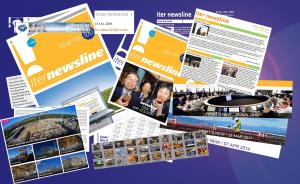Although the ITER Organization had yet to be established, they were the "ITER people" — physicists and engineers, administrators, assistants, accountants...
The
original seven had arrived in February 2006. By October, the "team" had grown into a few dozen and formed a community.
As new people kept joining in, as the ITER administrative, scientific and technological structures were being established throughout the world and as social life began developing outside the prefabricated offices, the ITER people, like any community, needed to be informed.
The ITER stakeholders, the researchers in their fusion laboratories and universities, the fusion enthusiasts throughout the world, and the general public shared the same need.
Something unique was happening in southern France: supported by 35 nations, the dream of three generations of fusion physicists was beginning to take shape.
Newsline was established to tell that story. Its
first issue, which came out on 18 October 2006, covered most of the topics that were of interest at the time and that continue to be of interest today: news from the recently established Domestic Agencies, a report on a fusion conference, the profile of a new recruit, and the account of a gathering of "family and friends" at the "exact future location" of the ITER Tokamak.
"As we all know, communication and public information play a vital role in a project like ITER," wrote ITER Director-General nominee Kaname Ikeda in his editorial. "I am convinced [...] that throughout its construction and its operation the significance of this project needs to be well understood by the public, and all stakeholders need to be well informed."
Over the past twelve years, through three Director-Generals and four Heads of Communication, Newsline has done its best to fulfil this mission. A monthly publication back in 2006 and 2007, it reached cruising speed in 2008 and has maintained its weekly periodicity ever since.
The publication has evolved. The chronicle of the nascent ITER community progressively gave way to a broader outlook on the fusion world, of which ITER is of course the centre piece.
Over the years, through close to 3,500 articles, a considerable
database has been accumulated. Most aspects of ITER science have been explored, the life story of major components had been reported from design through to completion, and progress on the worksite has been covered on a near-weekly basis.
Newsline has travelled to factories and laboratories throughout the ITER world; it has flown helicopters and climbed cranes to take in the full view of the construction site; it has sat through international conferences to report on the latest developments in fusion research, explored historical archives and collected memories of major fusion figures. The Newsline team has used every available means to share and convey the unique nature of ITER, its ambitions, its challenges.
Outside the ITER community, Newsline has approximately 8,000 subscribers worldwide and thousands more access it freely through the ITER website.
Its readership is diverse, ranging from the hard-core fusion scientist to the simple enthusiast. Catching the interest of the former without driving away the latter is the weekly challenge faced by the team.
The Newsline team is not alone in writing Newsline however. Whether spontaneous or solicited, contributions from the fusion community (whether ITER Organization, Domestic Agencies, fusion laboratories or universities) are always a precious asset.
Today, as we put together Newsline 500, we are already hounded by the ever-recurring Monday evening question: "OK, this one's out—but what do we have for the upcoming week?"
To answer this question, we just need to look through the windows to the construction site, exchange a few words with colleagues at the cafeteria or read our emails from partners working around the world—the stories are all there, waiting to be told.
ITER is a vast and fascinating world. Another 500 issues; another 3,500 articles won't be enough to explore it all.


